The Recovery of Gold in Low-Grade Cyanide Tailings by Chlorination Roasting
Abstract
:1. Introduction
2. Experimental Section
2.1. Roasting Experiments
2.2. Flotation Experiments
2.3. Effect Evaluation
2.4. Analysis and Characterization Methods
3. Results and Discussion
3.1. Composition of Cyanide Tailings
3.2. Influence of Roasting Temperature
3.3. Influence of Calcium Chloride
3.4. Effects of Copper Sulfide Concentrate
3.5. Influence of Internal Coke
3.6. Influence of External Coke
3.7. Influence of Kaolin
3.8. Phase Analysis of Roasted Pellets
4. Conclusions
Author Contributions
Funding
Data Availability Statement
Acknowledgments
Conflicts of Interest
References
- Liu, P.; Wang, J.; Yu, D.; Guo, X.; Tian, Q. Comprehensive Reclamation of Valuable Metals from Au-Bearing Cyanide Residue by Chlorination Roasting-Carbothermic Reduction-Magnetic Separation: Recovery of Iron. J. Sustain. Metall. 2021, 7, 1748–1761. [Google Scholar] [CrossRef]
- Altinkaya, P.; Wang, Z.; Korolev, I.; Hamuyuni, J.; Haapalainen, M.; Kolehmainen, E.; Yliniemi, K.; Lundström, M. Leaching and recovery of gold from ore in cyanide-free glycine media. Miner. Eng. 2020, 158, 106610. [Google Scholar] [CrossRef]
- Aghaei, E.; Alorro, R.D.; Tadesse, B.; Browner, R. A review on current practices and emerging technologies for sustainable management, sequestration and stabilization of mercury from gold processing streams. J. Environ. Manag. 2019, 249, 109367. [Google Scholar] [CrossRef]
- Alvillo-Rivera, A.; Garrido-Hoyos, S.; Buitron, G.; Thangarasu-Sarasvathi, P.; Rosano-Ortega, G. Biological treatment for the degradation of cyanide: A review. J. Mater. Res. Technol. JmrT 2021, 12, 1418–1433. [Google Scholar] [CrossRef]
- Li, H.; Wang, J.; Zhu, X.; Yang, T.; Deng, J.; Yan, B.; Mao, X.; Zhang, Y.; Li, S. Evaluation of a green-sustainable industrialized cleaner utilization for refractory cyanide tailings containing sulfur. Sci. Total Environ. 2022, 827, 154359. [Google Scholar] [CrossRef] [PubMed]
- Li, H.; Li, S.; Ma, P.; Zhou, Z.; Long, H.; Peng, J.; Zhang, L. Evaluation of a cleaner production for cyanide tailings by chlorination thermal treatments. J. Clean. Prod. 2021, 281, 124195. [Google Scholar] [CrossRef]
- Dong, K.; Xie, F.; Wang, W.; Chang, Y.; Lu, D.; Gu, X.; Chen, C. The detoxification and utilization of cyanide tailings: A critical review. J. Clean. Prod. 2021, 302, 126946. [Google Scholar]
- Li, Z.-Y.; Wang, W.-W.; Yue, K.; Chen, M.-X. High-temperature chlorination of gold with transformation of iron-containing phase. Rare Met. 2016, 35, 881–886. [Google Scholar] [CrossRef]
- Qin, H.; Guo, X.; Tian, Q.; Yu, D.; Zhang, L. Recovery of gold from sulfide refractory gold ore: Oxidation roasting pretreatment and gold extraction. Miner. Eng. 2021, 164, 106822. [Google Scholar] [CrossRef]
- Long, H.; Li, H.; Pei, J.; Srinivasakannan, C.; Yin, S.; Zhang, L.; Ma, A.; Li, S. Cleaner recovery of multiple valuable metals from cyanide tailings via chlorination roasting. Sep. Sci. Technol. 2021, 56, 2113–2123. [Google Scholar] [CrossRef]
- Li, H.; Peng, J.; Long, H.; Li, S.; Zhang, L. Cleaner process: Efficacy of chlorine in the recycling of gold from gold-containing tailings. J. Clean. Prod. 2021, 287, 125066. [Google Scholar] [CrossRef]
- Guo, X.; Qin, H.; Tian, Q.; Zhang, L. The efficacy of a new iodination roasting technology to recover gold and silver from refractory gold tailing. J. Clean. Prod. 2020, 261, 121147. [Google Scholar] [CrossRef]
- Qin, H.; Guo, X.; Tian, Q.; Zhang, L. Pyrite enhanced chlorination roasting and its efficacy in gold and silver recovery from gold tailing. Sep. Purif. Technol. 2020, 250, 117168. [Google Scholar] [CrossRef]
- Xu, C.; Cheng, H.-W.; Li, G.-S.; Lu, C.-Y.; Lu, X.-G.; Zou, X.-L.; Xu, Q. Extraction of metals from complex sulfide nickel concentrates by low-temperature chlorination roasting and water leaching. Int. J. Miner. Metall. Mater. 2017, 24, 377–385. [Google Scholar] [CrossRef]
- Wang, W.-W.; Li, Z.-Y. Recovery and kinetics of gold and iron from cyanide tailings by one-step chlorination-reduction roasting. Miner. Eng. 2020, 155, 106453. [Google Scholar] [CrossRef]
- Liu, S.; Feng, Y.; Li, H.; Wang, H. Simultaneous Extraction of Gold and Vanadium from Vanadium and Carbon-Rich Refractory Gold Minerals by Chlorination Roasting. Metall. Mater. Trans. B 2022, 53, 3955–3966. [Google Scholar] [CrossRef]
- Ge, J.; Xiao, Y.; Kuang, J.; Liu, X. Research progress of chlorination roasting of heavy metals in solid waste. Surf. Interfaces 2022, 29, 101744. [Google Scholar] [CrossRef]
- Han, W.-W.; Yang, H.-Y.; Tong, L.-L. Cyanide removal for ultrafine gold cyanide residues by chemical oxidation methods. Trans. Nonferrous Met. Soc. China 2022, 32, 4129–4138. [Google Scholar] [CrossRef]
- Tang, H.; Peng, Z.; Tian, R.; Ye, L.; Zhang, J.; Rao, M.; Li, G. Recycling of platinum-group metals from spent automotive catalysts by smelting. J. Environ. Chem. Eng. 2022, 10, 108709. [Google Scholar] [CrossRef]
- Zhang, L.; Jiang, T.; Guo, X.-Y.; Tian, Q.-H.; Zhong, S.-P.; Dong, L.; Qin, H.; Liu, Z.-W.; Makuza, B. Sustainable processing of gold cyanide tailings: Reduction roasting, mechanical activation, non-cyanide leaching, and magnetic separation. Hydrometallurgy 2023, 217, 106028. [Google Scholar] [CrossRef]
- Xing, Z.; Cheng, G.; Yang, H.; Xue, X.; Jiang, P. Mechanism and application of the ore with chlorination treatment: A review. Miner. Eng. 2020, 154, 106404. [Google Scholar] [CrossRef]
- Gülcan, E. A novel approach for sensor based sorting performance determination. Miner. Eng. 2020, 146, 106130. [Google Scholar] [CrossRef]

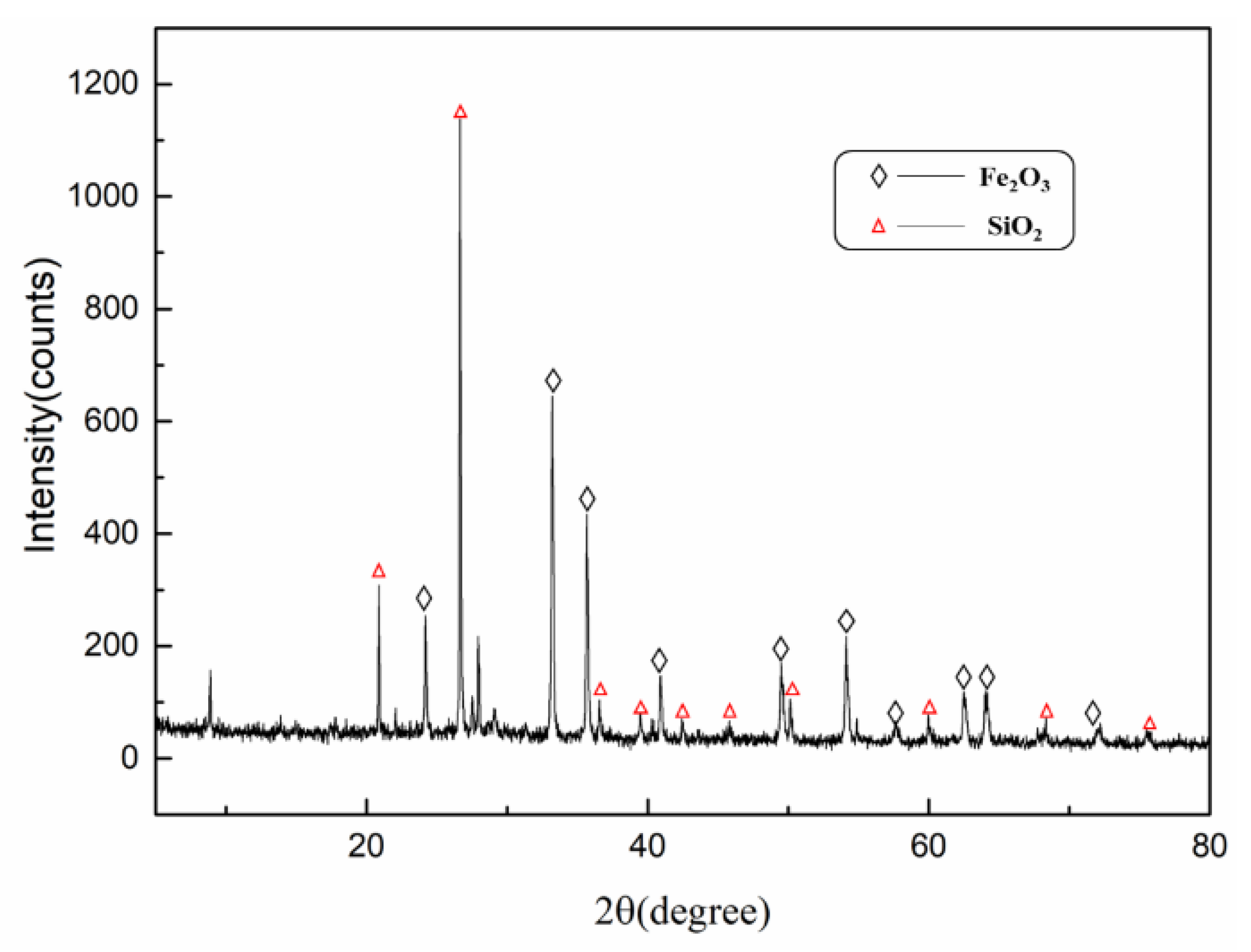
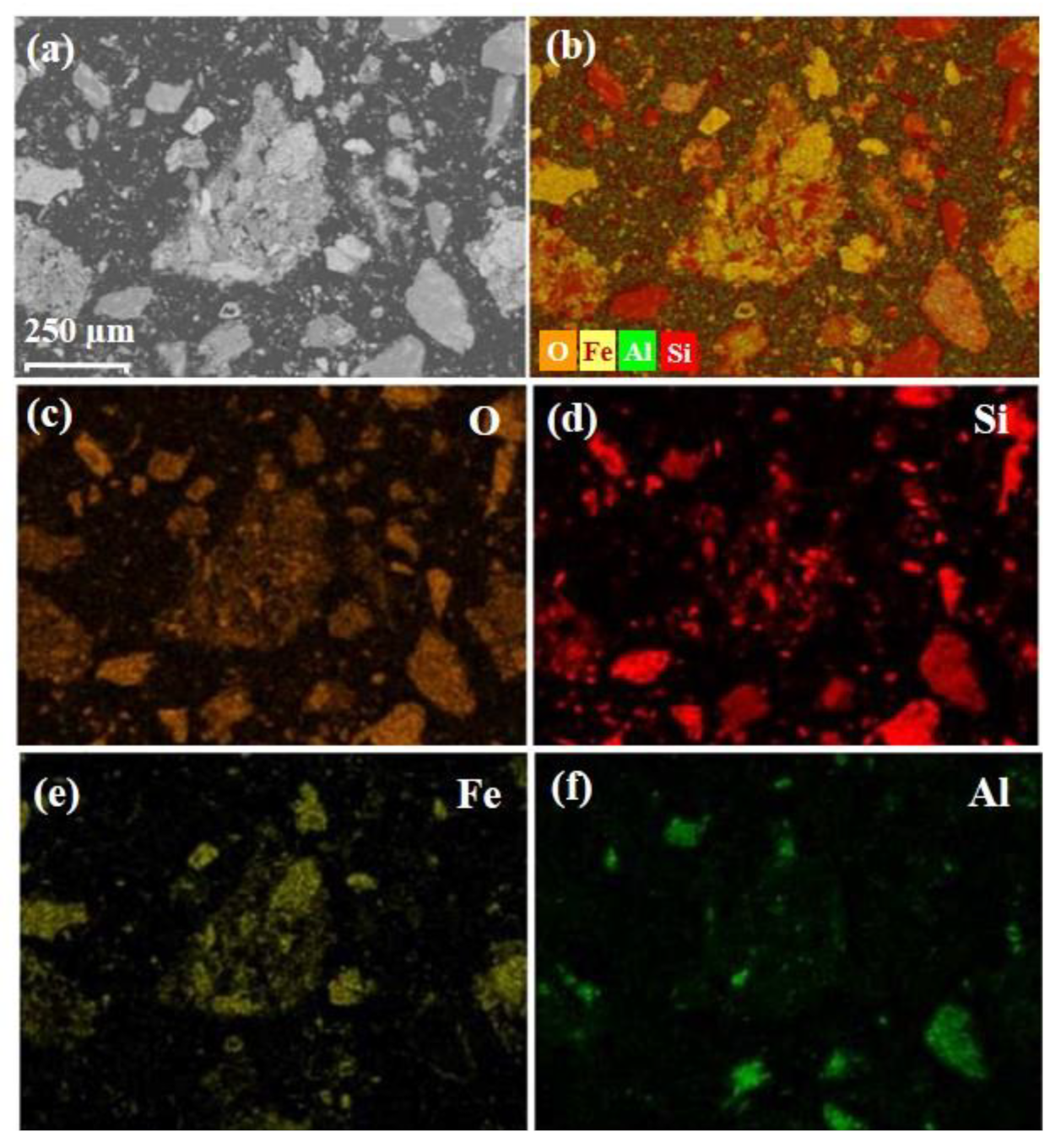
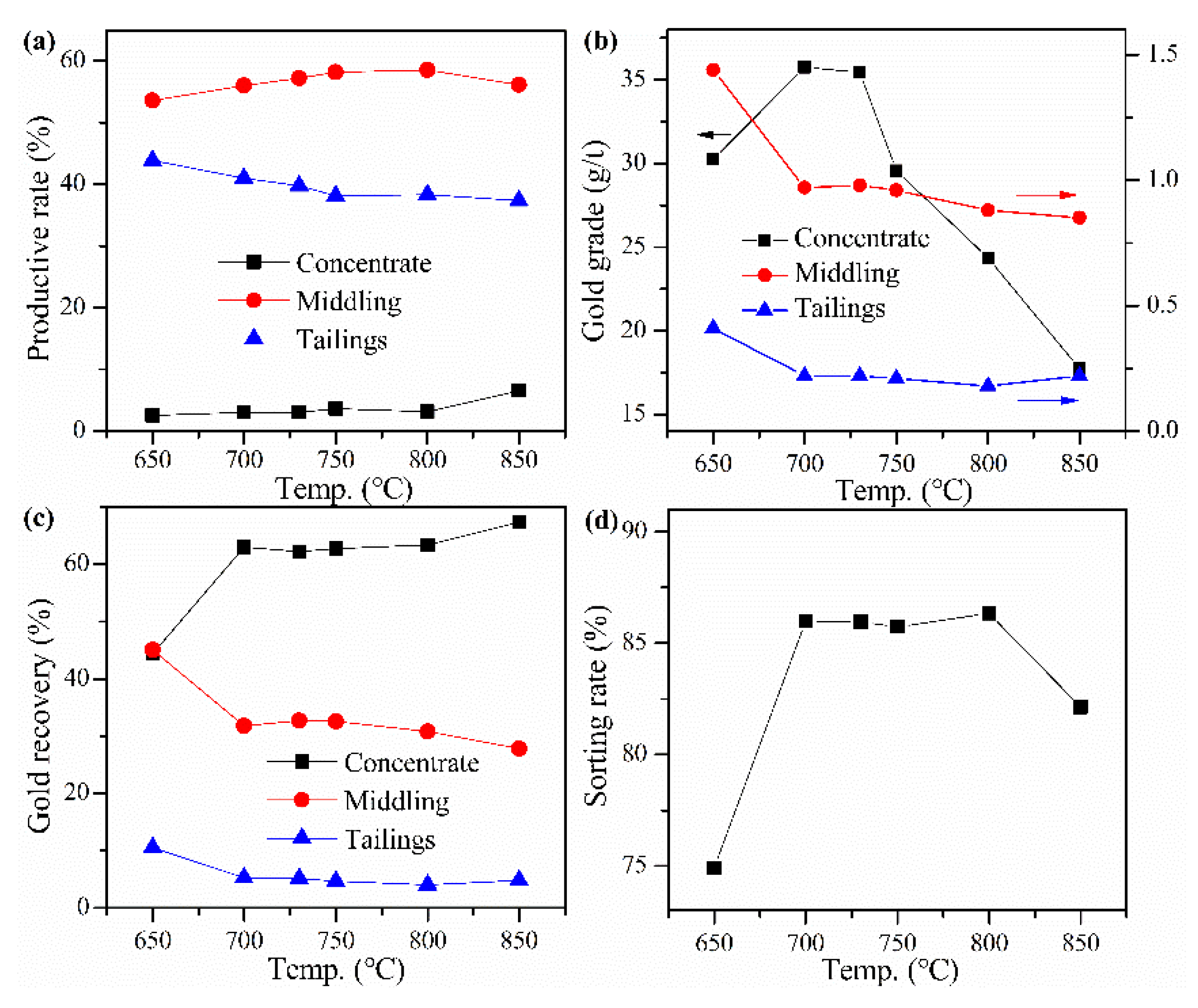
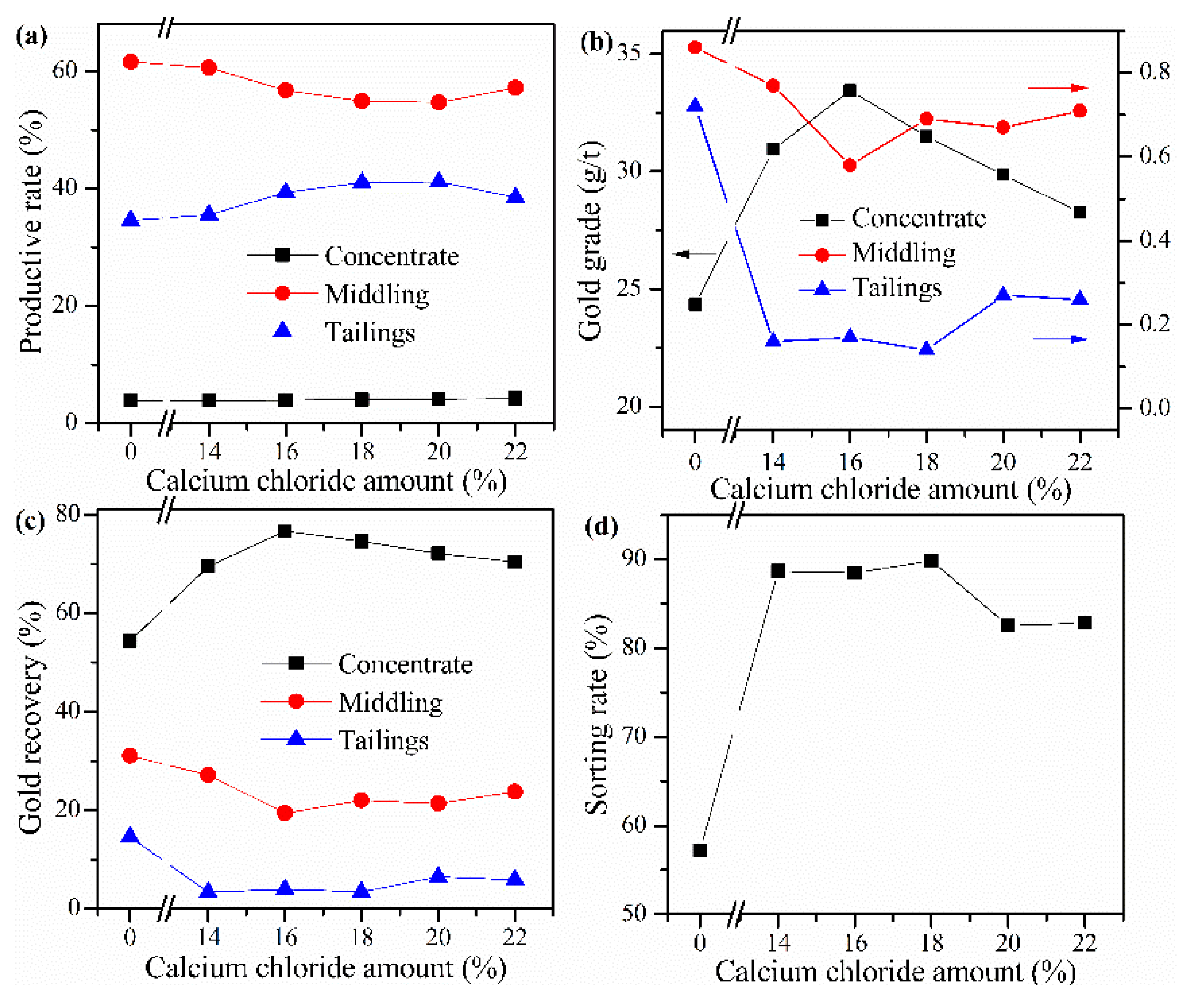



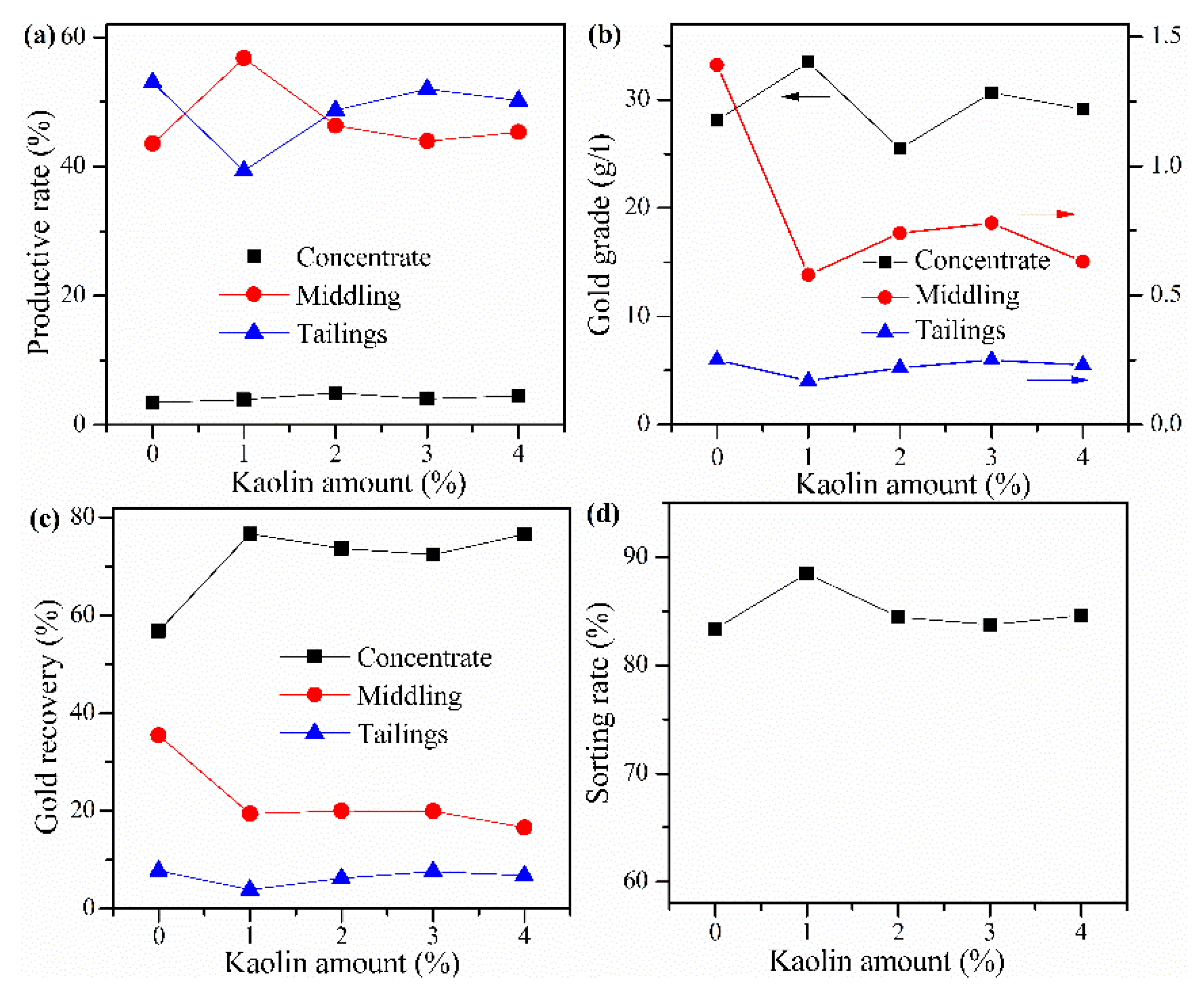
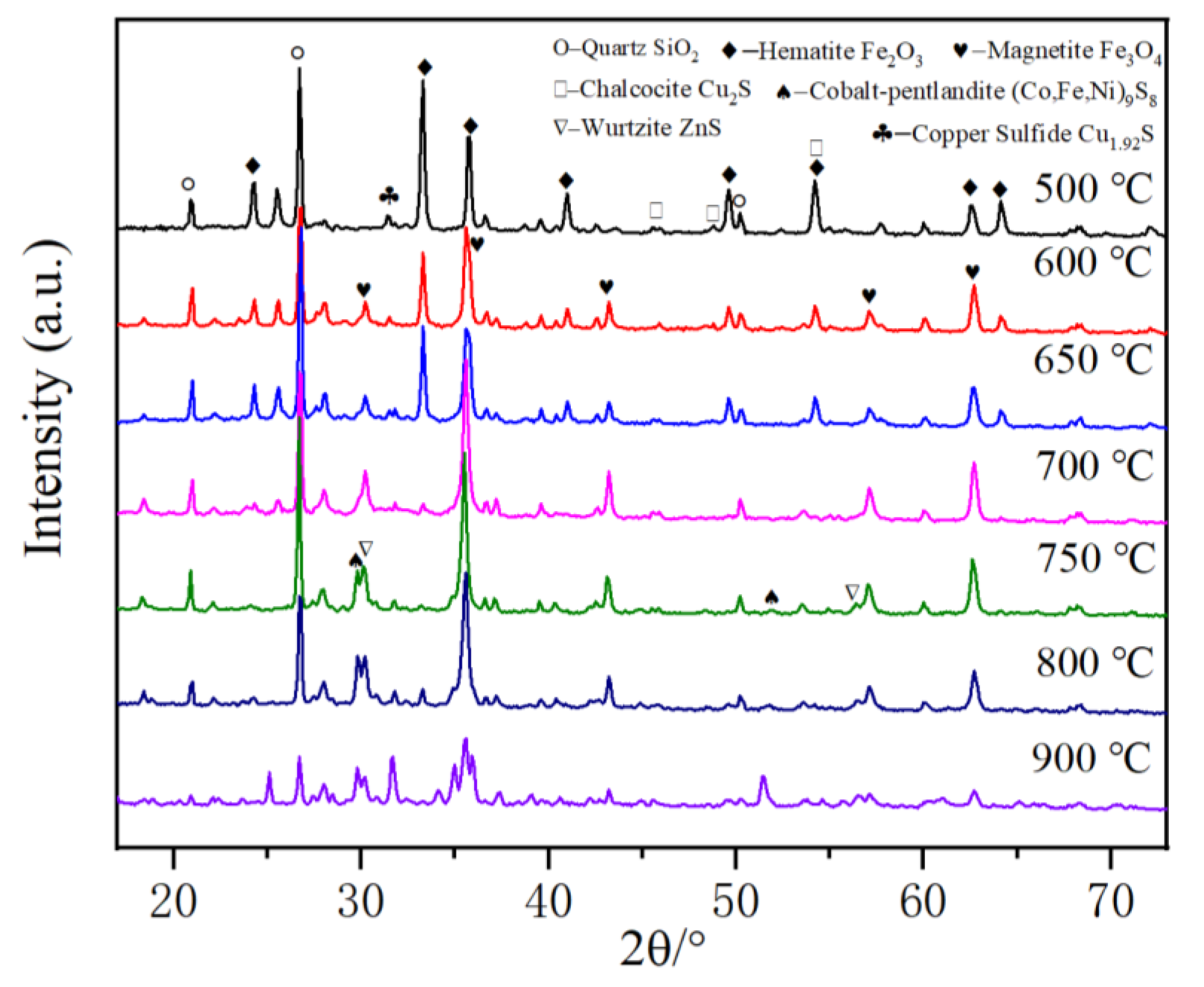

| Au g/t | Ag g/t | Fe | Cu | Ca | Na | Pb | Zn | S | Si |
|---|---|---|---|---|---|---|---|---|---|
| 1.71 | 54.0 | 32.71 | 0.33 | 1.13 | 0.88 | 0.86 | 0.42 | 1.38 | 8.28 |
Disclaimer/Publisher’s Note: The statements, opinions and data contained in all publications are solely those of the individual author(s) and contributor(s) and not of MDPI and/or the editor(s). MDPI and/or the editor(s) disclaim responsibility for any injury to people or property resulting from any ideas, methods, instructions or products referred to in the content. |
© 2023 by the authors. Licensee MDPI, Basel, Switzerland. This article is an open access article distributed under the terms and conditions of the Creative Commons Attribution (CC BY) license (https://creativecommons.org/licenses/by/4.0/).
Share and Cite
Sun, L.; Jiang, K.; Xie, F.; Zhang, Z.; Tang, J.; Mi, J.; Bai, Y.; Han, L. The Recovery of Gold in Low-Grade Cyanide Tailings by Chlorination Roasting. Minerals 2023, 13, 1042. https://doi.org/10.3390/min13081042
Sun L, Jiang K, Xie F, Zhang Z, Tang J, Mi J, Bai Y, Han L. The Recovery of Gold in Low-Grade Cyanide Tailings by Chlorination Roasting. Minerals. 2023; 13(8):1042. https://doi.org/10.3390/min13081042
Chicago/Turabian StyleSun, Liugen, Kaixi Jiang, Feng Xie, Zhengyang Zhang, Jigang Tang, Jianguo Mi, Yunlong Bai, and Luyang Han. 2023. "The Recovery of Gold in Low-Grade Cyanide Tailings by Chlorination Roasting" Minerals 13, no. 8: 1042. https://doi.org/10.3390/min13081042
APA StyleSun, L., Jiang, K., Xie, F., Zhang, Z., Tang, J., Mi, J., Bai, Y., & Han, L. (2023). The Recovery of Gold in Low-Grade Cyanide Tailings by Chlorination Roasting. Minerals, 13(8), 1042. https://doi.org/10.3390/min13081042






